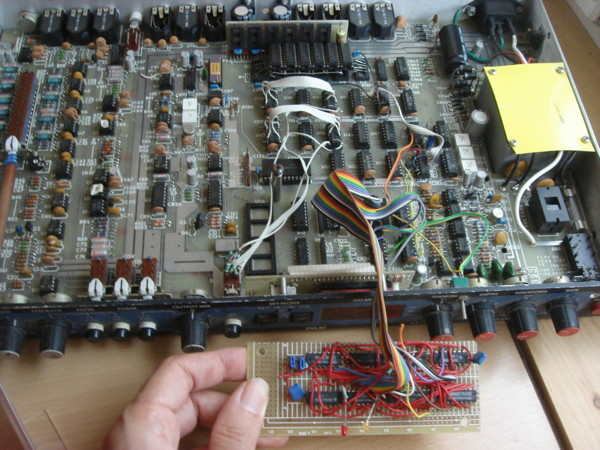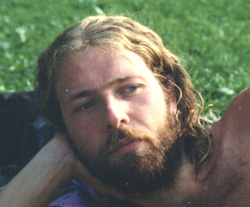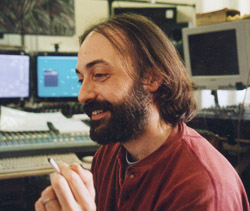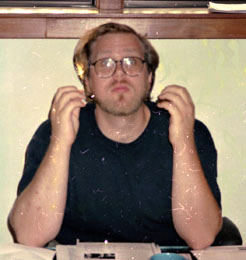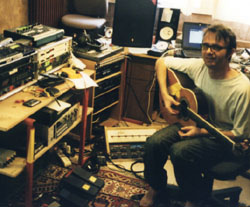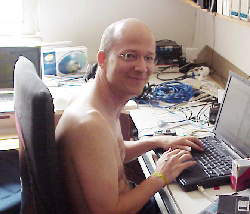The Development of the
LOOP delay / ECHOPLEX DP
LOOP delay / ECHOPLEX DP
1985, Matthias started to use a Roland 3000 delay with a volume pedal in the FeedBack insert to create sound carpets, as he called them, without knowing about Brian Enos work. They served for the daily exercises to ease his back problem. After half a year, the sound had cought over all of his interest and he started presenting it in public.
1987, Matthias traveled to t.c. electronics in Denmark to explain the necessity of loop functions for the 2290 delay to Kim Rishoj, who evaluated the functions carefully but found them only interesting for a "few esoteric" musicians. Listening to Matthias' music of that time, this is understandable :-)
1988, Matthias designed the Multiply function and sent the
proposal (pseudocode / time chart)
to Gary Hall at Lexicon, who liked the idea but thought that the sales
volume for Lexicon would be to small.
The letter to Roland
Corp. with a similar proposal was not quite understood and Rolands answer was
pretty negative.
1989, Matthias met Gary Hall at the music fair in Frankfurt and learned enough about the PCM42 from him to be able to build the first prototype of the Record and the Multiply function into Gary's personal PCM42 and Matthias made his music on this construction for about two year, confirming the usefullness of the functions.
a fun story about the later destiny of the unit:
1990, Matthias had the idea to bring the users of loop technology together to exchange music and information with the project LOOP Group. In 1995 he invited LOOP delay users for a common CD project but only got 4 contributors (Kuno Wagner, Michael Peters, Renato Rizzo, Andre Krikula) sent a DAT to Brasil. In 1996 the internet was introduced in Brasil and Kim Flint founded Loopers-Delight.com. There, more contributors became interested and the first Loopers-Delight CD finally was spread as CD-Rs in 1998, by Ray Peck. The second CD was a double with industrial quality, produced by Matt McCabe.
1991, Matthias decided to build the LOOP delay all alone. He was not aware of the effort for software, but destiny saved him by bringing Eric to the community of the beautiful chalet Musical Engineering was installed in. Here an old page documenting this central phase of development.
1992, we wanted to show it at Frankfurt Musikmesse but there was some crackling going on. I used the prototype on stage at Pirenopolis GO Brasil at the Festival de Arte Alternativa in June. in about October we started selling it.
1993 we did show it at Frankfurt Musikmesse and Ljubo demonstrated it all the time. Rolf Spuler invented to hang 3 units to the ceiling that were synced to the one that Ljubo played, so the display would show what he did no all of them. Here the funny texts we pined at the walls. and here the folder that explained the basics, also up the wall on the right.
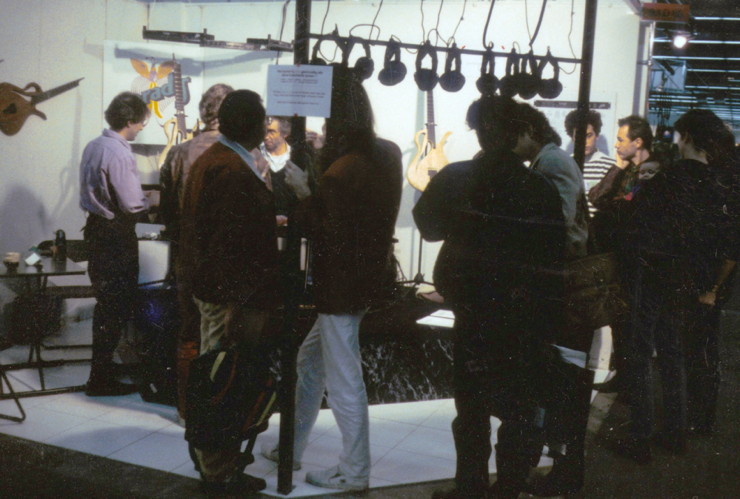
I had great friends helping me:
|
Eric Obermühlner had just gotten his
programmers degree and was without job yet when he moved to
live with the community in the beautiful old chalet Musical
Engineering was installed in. He was a dancing fool and
strictly barefoot on the road, resistant and consuming like
a bear. Personally very sensitive though, extremely sincere
and trying to make it right for everyone. He reads much
faster than anyone I know and knows more about everything
than anyone I knew of his age. Later Eric came to Brasil to elaborate the Echoplex and worked in Berkeley. Now he lives with his Brazilian wife and three kids in Switzerland and has about no time for looping any more. |
|
|
Willy Strehler did a fundamental job with testing and adding features needed with MIDI/sync and sequencing. He used to operate two LOOP delays with a one octave bass pedal and may have been the first one to use loops in his "holistic" guitar and voice lessons. The final test phase of Stereo/MIDI/sync happened in his studio. I hope we one day will be able to implement the innumerous creative/crazy suggestions he made. So far, Quantize, the Sync schema and many small tricks are his contribution. have a look at his equipment |
|
|
Ljubo Majstorovic came to PARADIS because he needed pieces for his home made guitars. We immediately understood each other about many technical and sound concepts. His incredible playing called the public to the booth in Frankfurt and and he explained the use of loops to many, in many languages! He also contributed ideas for functions. Arround 2002 he started to develop his own looper in Max which he is now selling as cusomized complete systems installed and with customized foot or hand controller, to musicians like Laurence Revey or Michael Schiefel... |
|
|
Marco Birchler of KENTEK, Zug, was the patient, sincere and responsible manager of the fabrication. After this project he gave up manufacturing to just deal with parts ;-) |
|
|
Dent-de-Lion DuMidi worked the English version of the manual through and kept digging us out of the dust with funny ideas and fantastic visions. |
|
|
Boris Bögli sensibly made the prospect and manual understandable. |
|
|
Thomas Oeschger is the supporting critic "outsider" judging from the listener's and reader's point. He made his thorough knowledge of human nature available to us &endash; not only when correcting letters. |
|
|
Thomas Bitterlin of DELFIN, Zürich, printed the housing carefully. |
|
|
Hermann Hogg of ALPHA77 is the discrete master that years ago taught me everything about electronics and much more. |
In 1993, the LOOP delay was presented at Musikmesse Frankfurt and its history changed:
Some representatives of Lexicon looked very closely at everything. The development of JamMan must have been advanced at that moment.
Keith MacMillen came up and said: "would you like to licence your
product?" - the dream of any European inventor. We soon made a
contract and the production of the LOOP delay stopped after the first
hundred because Gibson was able to manufacture cheaper in bigger
scale. A preliminary contract was signed quickly and after Matthias
moved to Brasil, he went to G-WIZ in Berkeley for a month, where improvements
were elaborated mostly implemented immediately.
A completely
new scene! :
|
Keith McMillen is the genius and incredibly active
creator of Zeta Music, ZIPI standard, BEAM foundation and recently a new company with the most advanced and practical ideas I can see on this market. Keith contributed many ideas for the improvements for the Echoplex Digital Pro like: - single jack cable for the pedals |
|
|
Kim Flint worked at G-WIZ in '93. It was at his first job after graduating. He did all the testing and implementing of the hardware changes, the front panel design... and fell in love with the whole idea and started to com up with suggestions. When G-WIZ closed, he stayed with the LOOP and without him, the project might have died in '95. He cleared the confused business connections, installed AURISIS (his parter Violet did the graphics) and LOOPERS-DELIGHT and convinced Gibson of the importance of looping. Kim also did most testing of the software, which is an amazing long and tiring process and he came up with solutions for inconsistencies, brought news from clients he cared for, organized the HW production over and over (since Gibson kept changing their sub companies)... and he wrote the upgrade manual, did the taxes... and he probably invested more into Loopers-delight than he gained from the Echoplex :-( |
|
|
Andy Ewen came to the project when Gibson decided to produce the Echoplex at Trace-Elliot in England, around 2000. He was leading the production and we all loved him for being so helpful, transparent and experienced. As a result, the Echoplex was better made than ever and customers were atended directly and quickly. |
picture lacking yet |
|
Claude Voit came in after making smart remarks on the Loopers-Delight mailing list and and finding the first bugs in the V5.0 soft. End 1999 he takes over Kims Job as tester and invents a lot of the finer Sync and MIDI features of the Echoplex. The fact that he is also swiss is a mere amazing coincidence! I ended up visiting him in Nyon where we worked out details on the spot and also played, twiced for the public at the lake side, at sundown...
|
|
|
Just like Claude, Andy Butler called attention on the Loopers-Delight list. First for his Vortex Data Base and then because he bought two EDP's and a week later found a bug - after no one had found any for years! Its a talent. Not only is he very carefull and observes and reports exactly, but the problems really happen more likely with him! (which is often not so fun, as any talent :-) End 2001 he started to do most of the testing and contributed FlipMode and other handy details to Loop IV Since 2002 working together on VST plug in projects and he became the leading force of Mathons.com Andy is autodidact musician and programmer and lives a modest and happy vegan life with his lovely wife Peta in a cozy house in the east of England... Johnny and Matthias ended up spending some time there for work and music and fun! |
|
Andy is the bridge to the next phase where he became a partner at Mathons.com.
Although he contributed little code directly to LOOP, he helped a lot with testing, discussing features, graphics... :
In 2002, the Echoplex got his final Software and the next step was hard:
Gibson was not interested in creating a new Hardware. A horrible lot of time was spent to squeeze the most into the old 68000 processor of the Echoplex and definitally the limits of its processor power, its memory and ASM programming was reached.
Gibsons sales badly fed Matthias because he was single and lived in cheap Brasil, but for Kim and Eric, Aurisis was just a free time project - a terrible difference, as we only understood when it was too late...
Matthias wanted to create a C++ version and thought a VST plugin was the right
Kim claimed that since ordinary computers are not real time oriented, they are not suited for this purpose, and that it would be too difficult to make money with software.
He was right in both points, but many loop on computers now, and to give away cheap software is interesting to be with the users and might have fed Matthias after Gibson stopped selling the Echoplex in 2008.
Kim wanted to create an independent hardware, but Matthias was afraid of the investment.
In general, Aurisis suffered a lot from the distance and the bad communication between the partners and a lot of energy was lost in missunderstandings until finally Matthias bought Kim's part in 2007 and in 2009 closed Aurisis LLC because it was too dificult to manage it from Brasil.
Keith MacMillen came up again and said: "I started creating a hardware looper, do you want to finish it?"
Again, he made a nice new ball roll
but it seems its going to come out different from what you might think...
for the virtual C++ version of the Echoplex, new great friends came to help:
|
Arround 2002/3/4, my
nephew Johnny Schmid tought me basic C++ programming and created our first VST plug-ins and
the virtual version of the Echoplex which first worked with a spanish hardware by Sound-Art called Chameleon.
Johnny plays guitar in a punk band and sometimes works as a sound mixer. 2008, Johnny got his diploma at the Federal Technical High School (ETH) in Zürich. His speciality is now animation and he works in a Disney project! |
|
|
2004, Bernhard Wagner visited Matthias in Brasil and they spend marvelous times on a island, enjoying food and nature during the day and programming at night. He is a professional in Software Architecture and helped structuring LOOP in a way that it became compilable on several platforms. It worked for VST and Chameleon at the time. Then the Chameleon platform was abandoned and the same structure hopefully helps for the new hardware version now! Bernhard plays and amazing funky guitar and is always ready to jam, but also recorded some beautiful relaxing CD's... |
|
|
2009 Matthias finally found a partner in Salvador: Pedro Andrade just finished his high school diploma and was decided to spend his time half playing and the other half creating tools for musicians. Hardware rather than software, but he knows about both, and so far it seems that the young freshly informed power adds well to the slowing down but experienced one... Pedro is an amazing guitar player, very versatile between chorinho and punk... watch one of his bands Vendo 147 !)
|
picture lacking yet... |
